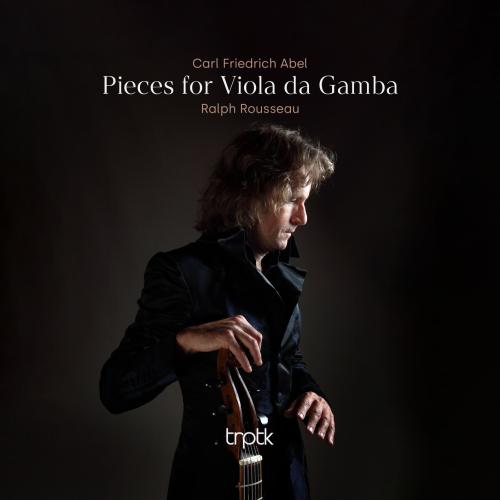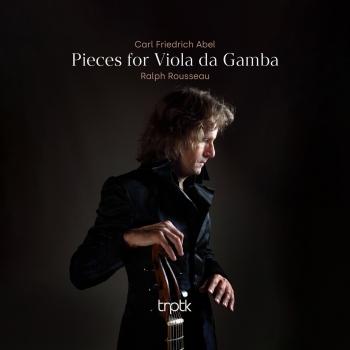
Abel: Pieces for Viola da Gamba Ralph Rousseau
Album Info
Album Veröffentlichung:
2023
HRA-Veröffentlichung:
22.12.2023
Label: TRPTK
Genre: Classical
Subgenre: Instrumental
Interpret: Ralph Rousseau
Komponist: Carl Friedrich Abel (1723-1787)
Das Album enthält Albumcover
- Carl Friedrich Abel (1723 - 1787): Sonata in D major:
- 1 Abel: Sonata in D major: I. Moderato 02:59
- 2 Abel: Sonata in D major: II. Adagio 03:34
- 3 Abel: Sonata in D major: III. Rondo - Vivace 03:57
- 4 Abel: Sonata in D minor: I. Allegro 04:42
- 5 Abel: Sonata in D minor: II. Adagio 04:36
- 6 Abel: Sonata in D minor: III. Tempo di minuet 02:16
- 7 Abel: Sonata in D minor: IV. Allegro 03:35
- Sonata in A major:
- 8 Abel: Sonata in A major: I. Allegretto 03:39
- 9 Abel: Sonata in A major: II. Adagio 02:21
- 10 Abel: Sonata in A major: III. Presto 01:35
- Sonata in D minor:
- 11 Abel: Sonata in D minor: I. Arpeggio 01:50
- 12 Abel: Sonata in D minor: II. Fuga 03:34
- 13 Abel: Sonata in D minor: III. Adagio 03:26
- 14 Abel: Sonata in D minor: IV. Allegro 01:53
- Sonata in D major:
- 15 Abel: Sonata in D major: I. Andante 03:32
- 16 Abel: Sonata in D major: II. Tempo di minuet 02:57
Info zu Abel: Pieces for Viola da Gamba
Even though Abel left behind a sizable oeuvre, including many symphonic works, he is maybe best remembered for his extraordinary compositions for the “queen of all instruments”, as he called it: the viola da gamba.
Having been a true celebrity in the second half of the 18th century, Carl Friedrich Abel has since been largely forgotten. At least, forgotten outside of the viola da gamba community. He was a cellist, composer, and viola da gamba virtuoso, most well-known for his establishment and subsequent managing, together with a son of the great J.S., Johann Christian Bach, of the appropriately-named and extremely successful Bach-Abel concert series in London. Between 1764 and the untimely death of Johann Christian in 1782, this series defined the musical world of London. Abel was sharing a house with Johann Christian at the time and the two must have been extremely close. Abel was devastated by the death of his friend, and turned to alcohol and his fatherland for consolation. Both without success.
Even though his performances on the viola da gamba continue to receive high praise in the London press right up until his death in 1787, Abel more and more relied on spirit drinks to perform on stage after the passing away of Johann Christian. He was reputedly sometimes in such a state that two men were needed to carry him onto his chair before the concert. This apparent loss of control notwithstanding, he then proceeded -according to the papers- to improvise more beautifully than ever before.
With the Bach-Abel series coming to an end in 1782, Abel returned to his fatherland for inspiration and in order to be introduced to the latest musical fashion. He composed several sonatas in the Berlin style of the time before returning to London, where he died a few years later. The French Revolution was then only two years away. The viola da gamba had gone almost completely out of fashion. The contemporary papers concluded, that with the death of Carl Friedrich Abel, the viola da gamba was in effect buried alongside him. It would indeed be 150 years before both the instrument and Abel’s music would again find recognition.
How did the son of cellist Christian Friedrich Abel and Anna Christina Holm, born in Cöthen on December 22, 1723, become an international celebrity in the far-away city of London? J.S. Bach had just left Cöthen for Leipzig at the time of his birth, but the two families were very friendly and it is even assumed that the famous suites for violoncello solo were actually composed for Abel’s father. It is also probable that Bach assisted in establishing Abel’s musical career, since Abel was living in Leipzig in the late 1730s, after the death of his father.
It is certain that Abel was employed as a cellist by the Dresdener Kapelle and he gradually moved into composing as well, publishing his works from 1750 onwards. But in 1757 disaster struck, as Dresden was almost completely destroyed during the Seven Year War between Prussia, Saxony, and Austria. Abel became a European refugee, travelling to Frankfurt am Main, where he reportedly spent some time with the family of Johann Wolfgang von Goethe, before moving on to Paris and eventually to London. He may have been just in time to witness Händel’s last performances. It was his encounter with Johann Christian Bach that turned Abel’s luck around, at least for a decade and a half.
It was during the early years of the Bach-Abel concert series that Karl Friedrich received a visit by Leopold Mozart, showing off his prodigy offspring. Indeed, the young Wolfgang Amadeus received music lessons from the great Abel. Mozart apparently used some themes by Abel in in his 18th symphony, and it is even rumored that Mozart did in fact compose some works for the viola da gamba during his stay in London. Just imagine that: actual notes for the viola da gamba by Mozart. What a tantalizing idea! What a dream for any viola da gamba player! And what a deception that these works -if they ever existed- have never been found.
Even though Abel left behind a sizable oeuvre, including many symphonic works, he is maybe best remembered for his extraordinary compositions for the “queen of all instruments”, as he called it: the viola da gamba. Every viola da gamba player is familiar with some of his work. Many of us have started our education with the easy pieces with basso continuo, gradually moving to the extremely demanding and rich repertoire for solo viola da gamba. It is this repertoire that is recorded on this album. It is so special to be able to record these sweet, emotional, deeply moving, and elegant pieces, since it is through this music, more even than by means of the works of Carl Philipp Emmanuel Bach, that one hears the new era approaching, the era of romanticism. The works of Mozart for the viola da gamba may never be found. But by playing and listening to the music of Abel, one gets a glimpse of what it may have sounded like.
For me, Carl Friedrich Abel will always remain the Mozart of the gamba.
Ralph Rousseau, Viola da Gamba
Ralph Rousseauknew
very early on that music and science would be dominating factors in his life. Playing the piano and bass guitar at the age of eight he later combined his conservatoire double-bass studies with a university physics degree, graduating ‘cum laude’ in both.
His professional career started as a double-bass player, where he performed with, among others, the Royal Concertgebouw Orchestra. As a researcher, he worked for Shell and for the Dutch Organisation for Scientific Research. He combined this with pop, jazz and rock music.
His first, fortuitous, acquaintance with the viola da gamba made him switch instantly. He studied with Jaap ter Linden and rapidly became the most prominent Netherlands ambassador for the seven-stringed instrument. His many recordings of composers such as Telemann, Bach, and Marais have been internationally praised and his cross-over work has also gained exceptional recognition. Ralph’s album Chansons d’Amour was awarded the Edison classical audience award, the Netherlands’ most prestigious cd award.
Ralph’s greatest strength is his interpretation of the works for solo viola da gamba.
The presentation of his concerts is very personal; he introduces the works himself and his commentary creates an intimate atmosphere even in the largest of halls. He is currently working in the theatre as well, performing one-man shows with such directors as Justus van Oel and Han Peekel.
He has been gamba soloist with the Royal Concertgebouw Orchestra, the Arnhem Symphony Orchestra, the Residentie Orchestra Bach Ensembles, the North-Netherlands Orchestra, the Philharmonia Orchestra and the Krakow Philharmonic Orchestra, with such conductors as Sir Roger Norrington, Vladimir Ashkenazy, and Ivan Fischer, but also with popular musicians as Lenny Kuhr, Ad Visser, and Eric Vloeimans. Various composers have created new works for him and his solo concerts have brought him to music festivals throughout Europe, the United States, Thailand and China.
Son of a teacher, Rousseau displays a keen interest in education. In 2011 he decided to do the Master of Education, graduating cum laude in the field. He actually worked as a physics teacher in secondary education for some time, before accepting a position as an assistant professor at Utrecht University, where he is currently researching intrinsic motivation, the deepest driving forces of students, learners, and people in general.
Ralph is a macrobiotic cook, an accomplished t’ai chi practitioner, he has been mediating daily for 35 years, and is fascinated by history, astrophysics, and aviation. He obtained his private pilot’s licence (PPL) in 2009.
Ralph’s unorthodox combination of activities and the lessons learned in the different fields, combined with his professional insights in motivational theory, have made him a popular public speaker in the field of inner driving forces and intrinsic motivation.
Dieses Album enthält kein Booklet










